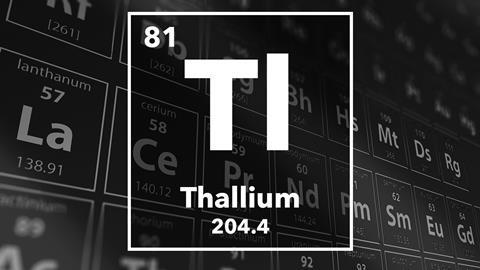Thallium
Image Source here
Background 1
Thallium is a soft, bluish-gray, malleable heavy metal. It was discovered in 1861 by Sir William Crookes while he was making a spectroscopic determination of tellurium on residues from a sulfuric acid plant. It can be found in pure form or combined with other substances such as bromine, chlorine, fluorine, and iodine to form salts. Thallium exists in two chemical states (thallous and thallic). Thallium is most commonly found in electronic devices, switches, and closures. It can also be sued in glass to increase its refractive index and density as well as rat poison. Thallium is produced or used in power plants, cement factories and smelters. Since 1984 thallium is no longer produced in the United States because of its causes potential harm to humans. Even though levels of thallium are low, some people can be exposed to thallium can be via air, water, and food. 1
Image source here
Piece of pure thallium in glass ampule under argon.
Toxicokinetics 1
Absorption
- Studies indicate thallium compounds are readily absorbed by various routes of exposures. Water-soluble salts are rapidly and completely absorbed from the respiratory tract, gastrointestinal tract, or skin. Little data is provided about thallium absorption.
Distribution
- Studies show that thallium is distributed through the body, a female cancer patient was given a tracer dose of 1.8 mg thallium orally. The thallium tissue levels reported as a percent of average body distribution per gram were highest in scalp hair, renal papilla, renal cortex, heart, bone tumor, and spleen Distribution in animals shows traces in kidneys, followed by the heart, brain, bone, skin, and blood. Thallium as thallous sulfate has been known show cross the placement and locate in the fetus within 15 minutes following intraperitoneal injection 5.
Metabolism
- No studies were found regarding the metabolism of thallium in humans or animals.
Excretion
- Studies show that excretion was detected in urine 5.5 days postdosing and in feces 3 days. Excretion half-life for this element is estimated to be 21.7 days in humans,
Carcinogenicity 3
Under the EPA’s guidelines for carcinogen risk assessment, no studies were located in humans or animals after inhalation, oral or dermal exposure.
Mechanism of action 3
The exact mechanism of toxicity for thallium is unknown. Monovalent thallium is similar to potassium in ionic radius and electrical charge. Monovalent thallium also inhibits the influx and efflux of potassium in rat liver mitochondria at concentrations that do not affect oxidative phosphorylation. Thallium may exert toxicity by disturbing mitochondrial function. Uncoupling of oxidative phosphorylation and swelling of isolated mitochondria is caused by thallium acetate. As well as an increase in oxygen consumption and active acid production in ascites tumor cells in vitro. Other research suggests that thallium may trigger toxicity through the induction of oxidative stress. Thallium hydroxide decreases the content of GSH and inhibits glutathione peroxidase and glutathione reductase activities, which suggests that thallium impairs the glutathione-dependent antioxidant defense system.
- Peripheral system
- Control nervous system
- Gastrointestinal tract
- Skin
- Liver
- Kidney
- Cardiovascular system
- Reproductive system
- Possibly the developing fetus
Sign and Symptoms of toxicity 3

Acute Toxicity
- Alopecia
- Lethargy
- Ataxia
- Abdominal pain or vomiting
- Back pain
- Abnormal reflexes
- Neuropathy
- Muscle weakness
- Coma
- Convulsion
- Other neurological symptoms include ( mental abnormalities, tremors, abnormal movement, abnormal vision, headache)
Chronic Toxicity
- Sleep Disorder
- Tiredness
- Weakness
- Nervousness
- Headaches
- Psychological alteration
- Neurological and muscular problems.
Treatment 2,
Fe7(CN)18 Prussian Blue
Image source here
Treatment of thallium poisoning includes Prussian blue treatment. This works by binding to the metals in the digestive tract to keep the body from absorbing them. Another treatment for thallium poisoning is oral administration of activated charcoal, forced diuresis, potassium ferric hexacyanoferrate.
Biomarkers1
Thallium levels in
- urine – the most widely used biological indicator of thallium exposure.
- blood – detected in blood but cleared out very rapidly. Reflect recent exposures.
- hair – dark pigmentation of the hair roots and hair loss are common features.
- Neurological damage
Genetic Susceptibility or Heritable traits 2,
Studies have suggestive evidence that thallium compounds can adversely affect male reproductive organs and the developing fetus. Thallium 204 has been shown to cross the placenta and locate the fetus within 15 minutes following intraperitoneal injection. Thallium may also be passed on through breast milk to infants.
Historical Exposure 3, 4

Image source here
Thallium has historically been used as a rodenticide but has since been banned in the united state due to its toxicity from accidental exposures. In October 1988, five individuals from a family living in florid were poisoned with thallium. Three patients had acute server neuropathy with respiratory depression, two had no symptoms and 1 had died.
Resources
1.“TOXICOLOGICAL PROFILE FOR THALLIUM .” CDC, www.atsdr.cdc.gov/ToxProfiles/tp54.pdf.
2. “Thallium.” Thallium (PIM 525), www.inchem.org/documents/pims/chemical/pim525.htm#SectionTitle:2.1%20%20Main%20risks%20and%20target%20organs.
3. “TOXICOLOGICAL REVIEW OF THALLIUM AND COMPOUNDS.” EPA, 2009, cfpub.epa.gov/ncea/iris/iris_documents/documents/toxreviews/1012tr.pdf.
4. Desenclos, J C, et al. “Thallium Poisoning: An Outbreak in Florida, 1988.” Southern Medical Journal, U.S. National Library of Medicine, pubmed.ncbi.nlm.nih.gov/1470964/#:~:text=In%20October%201988%2C%20five%20of,with%20respiratory%20depression%3B%20one%20died.
5. Barclay RK, Pencock WC, Karnofsy DA. 1953. Distribution and excretion of
radioactive thallium in the chick embryo, rat, and man. J Pharmacol Exp Ther
107:178-187.

